Introduction
“How to clean my humidifier step by step?” – Anonymous
Here, you will learn how to clean a humidifier, step by step, and what the device is in terms of usage and working process.
A humidifier serves the most reasonable purpose in the winter season. It does not only help you stay humid during cold, dry weather and offers a protective wall against diseases such as sinus, mucous membranes, and more.
There could be endless reasons you need a humidity machine at home, provided you know the necessary basics of the device and certain limitations to use it without any risks.
Although a humidity machine is an entirely safe device, it becomes mandatory to know your tool from A to Z for proper usage. It includes ideal usage of the device, which kind of Humidity machine you should invest in, how to clean humidifier, and the list that goes on!
Considering the scenario mentioned above, we developed a comprehensive blog post to introduce you to vaporizers effectively. It’s better to skim the content until the end as you may not be aware of certain cleaning and maintenance facts of a humidity machine even until now.
What is a humidifier? What does a humidifier do?
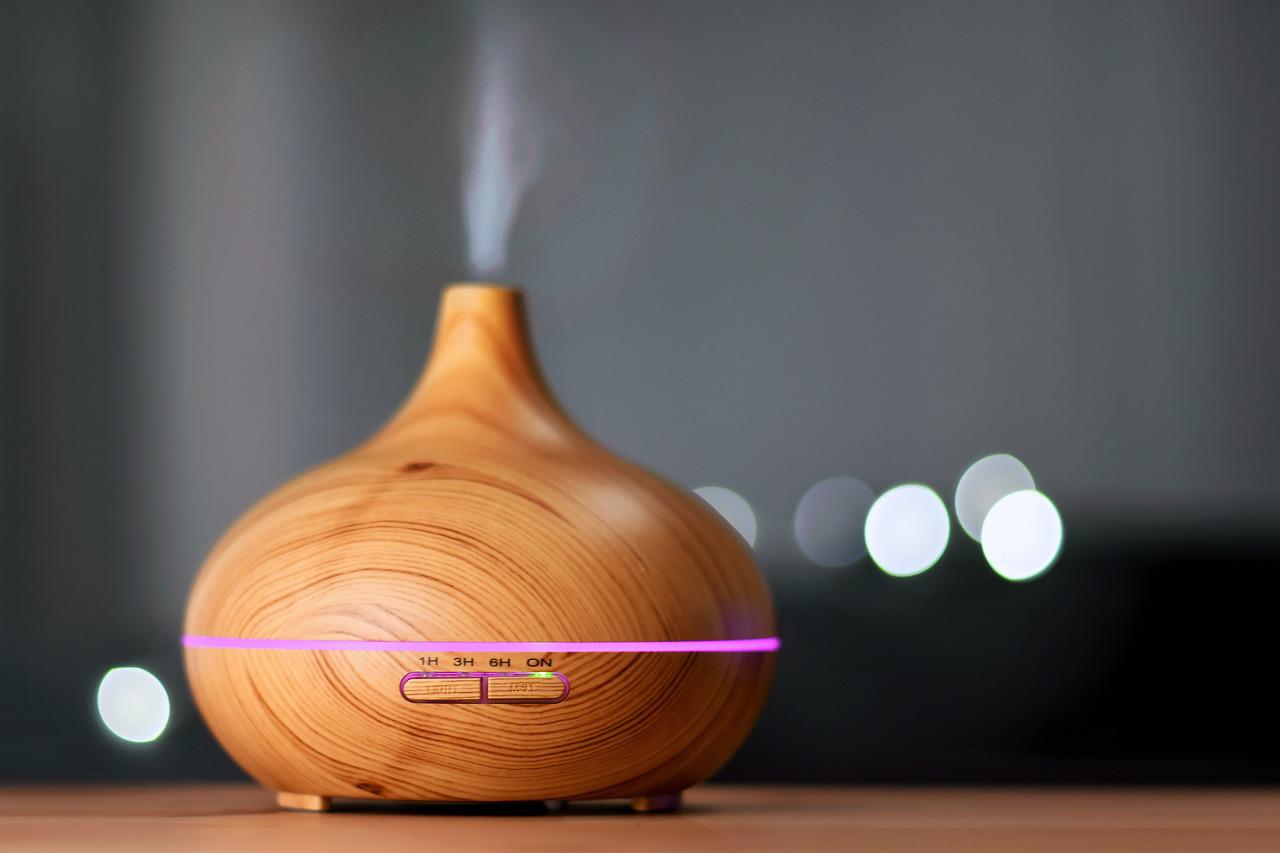
Image Source: Pixabay
This is a humidity-inducing device generally used in winter to maintain the ideal relative humidity in homes, offices, or other areas. FYI, about 45% to 50% relative humidity is ideal to maintain in a particular area to feel well. Otherwise, you may feel too cold or too hot.
Moreover, living in an imbalanced humid area can also lead to various medical issues such as sore throat, dry cough, allergies, irritated eyes, dry skin, worsening symptoms of sinus, etc. Humidifiers are primarily used in winter because of the dry air in the weather.
Too much dry air can make you feel super breezy and can lead to the worst respiratory issues over time. So, a vaporizer must spread moisture within the dry air to balance the ideal relative humidity level.
So, it simply means they are not meant to clean the air. They are only related to the purpose of maintaining humidity. It is the air purifier that serves the purpose of cleaning the air.
How do I know what type of humidifier I need?
Not all humidifiers are suitable for your requirements and weather conditions. Thus, you must explore the variety of air moisturizer first and then choose accordingly.
Most commonly, air moisturizer can be divided into five categories as defined below.
1 – Cool Mist Humidifiers

Image Source: Vicks Humidifiers
A cool-mist humidifier has various medical benefits and is suited for a too-dry air scenario. This device is suitable for the cold environment where you have a high chance of dry cough or congestion.
These devices are mainly made to expel cool mist and vapor into the air. It’s also easy to afford and maintain. Moreover, these kinds of devices are also safe to use for pets and kids in your home. If you or your child suffer from cold and flu symptoms, you can add inhalants to most cool mist humidifiers.
2 – Warm Mist Humidifiers
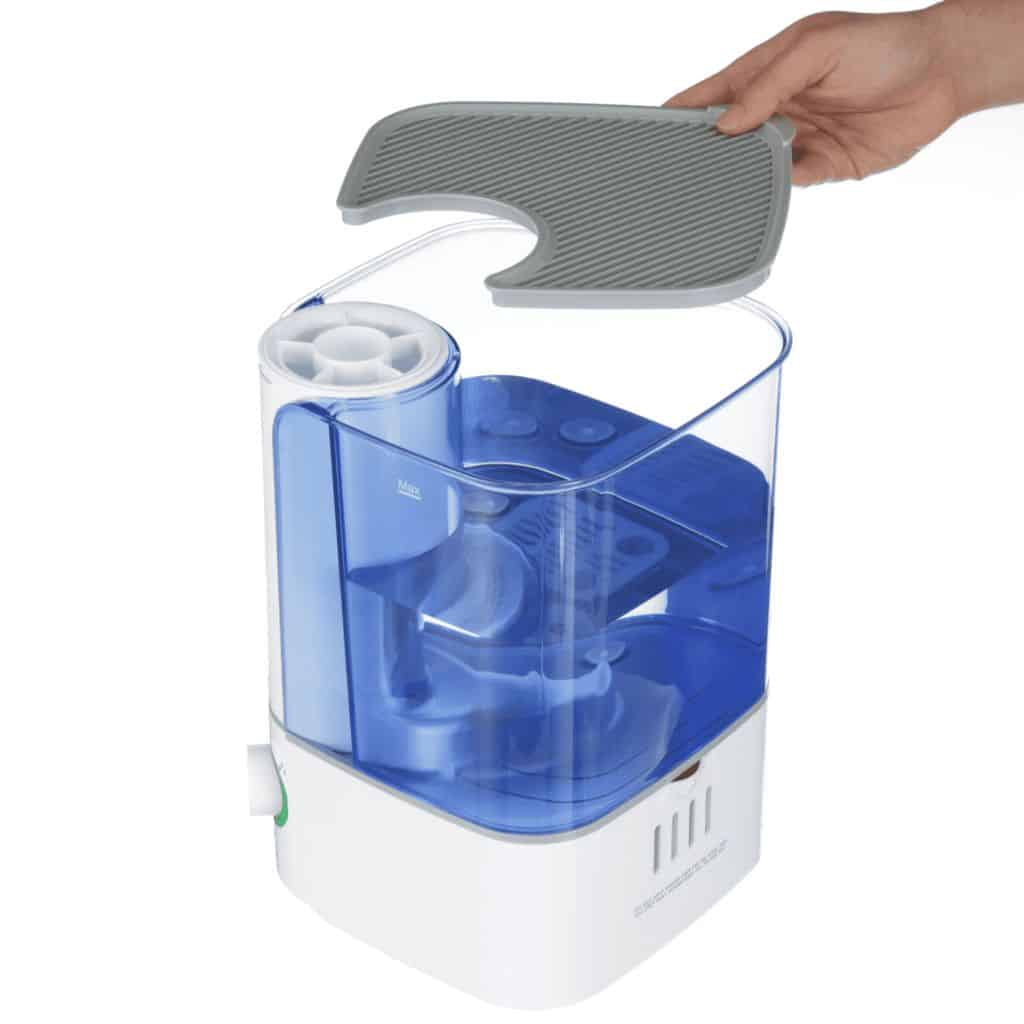
Image Source: Ubuy Zambia
On the other hand, warm mist humidifiers are best for colder climates as they heat the water to create a vapor. They equip an internal heating film to release boiling water as an invisible mist into the environment.
However, there is a caution regarding these Vaporizers for kids or infants as their heated water vapors can cause burns. They are one of the best tools to reduce bacteria and germ buildup and achieve levels of high moisture saturation. The warm mist humidifier is also compatible with medicated products or inhalants.
Thus, cool mist and warm mist are two types of capabilities of a humidifier. Some options contain both capabilities as well. It’s better to operate the device on the warm mist settings during the winter and change it back to relaxed mist settings in summer.
3 – Vaporizer Humidifiers
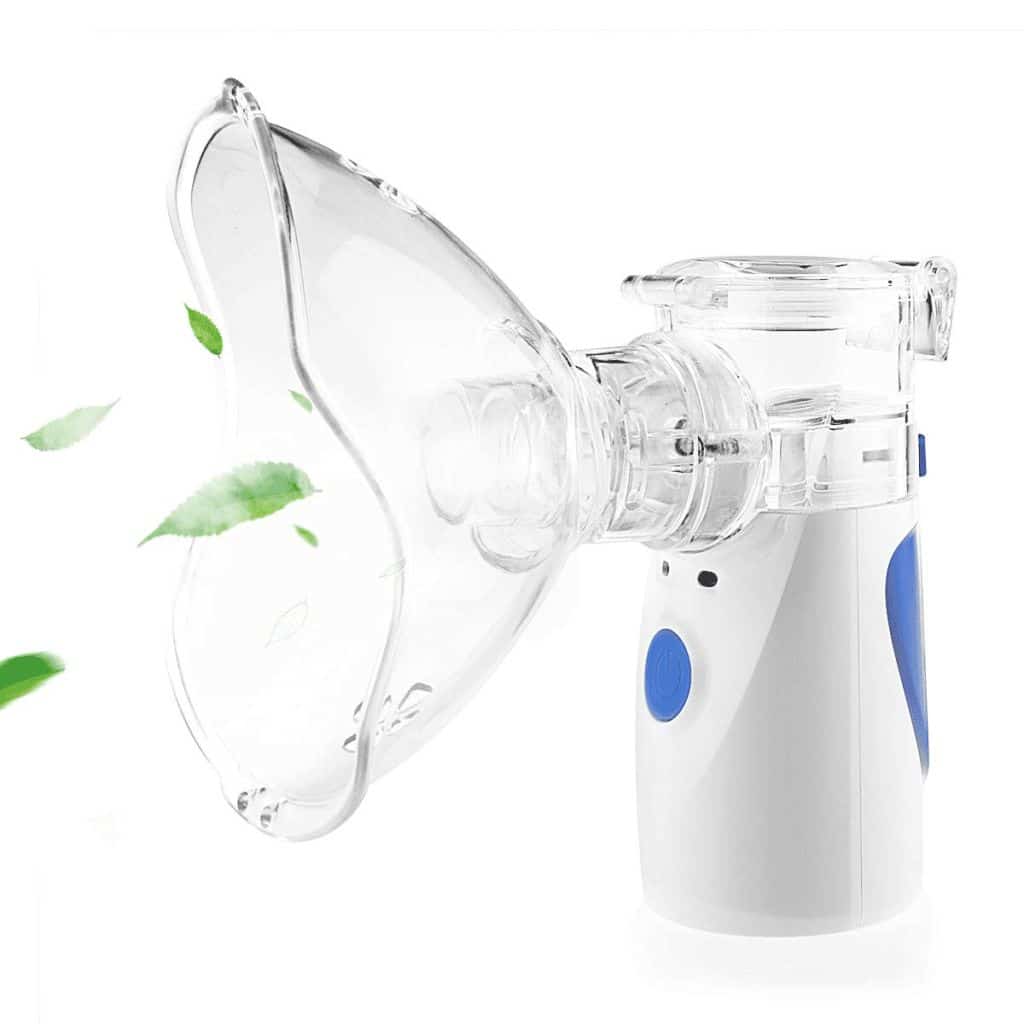
Image Source: Amazon
The two-in-one option discussed in the previous point is a vaporizer humidifier. They are accessible for both the cool mist and warm mist settings within a single device.
You can add inhalants to the device just in case you suffer from flu and cold symptoms. These humidifiers are available at an affordable price even after considering their multi-purpose features. Moreover, these types are quieter comparatively and accumulate the minimum dust possible.
However, vaporizer humidifiers have a few downsides as they are harder to clean. Also, their heat settings may still threaten children or little kids with burns.
4 – Evaporative Humidifiers
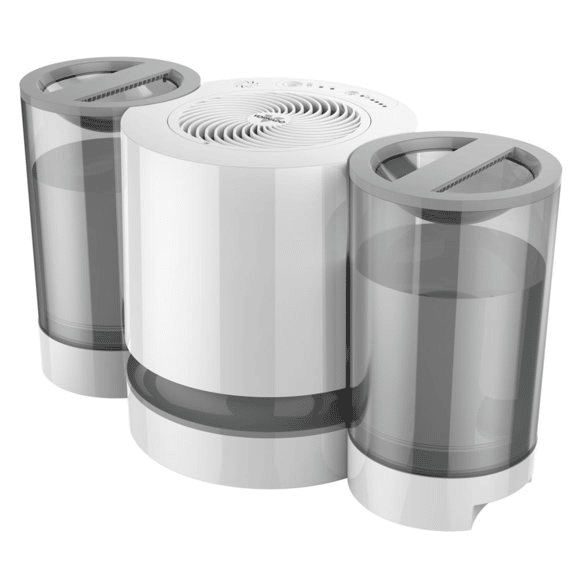
Image Source: Walmart
Evaporative humidifiers are a subtype of cool mist humidifiers as they don’t heat the water to make vapors. Instead, they use their internal fans to circulate humidity via a wick filter.
They are the most suitable devices for kids or pets as they expel the mist or spray into vapors to create a humid environment. Furthermore, they can easily be placed on any surface, including furniture.
Moreover, they are self-regulating, affordable, and portable devices that also help adjust humidity levels entirely automatically. They have zero chance of creating mineral dust while delivering invisible, clean moisture particles into the air. They make low operating noise like other cool mist humidifiers.
5 – Ultrasonic Humidifiers
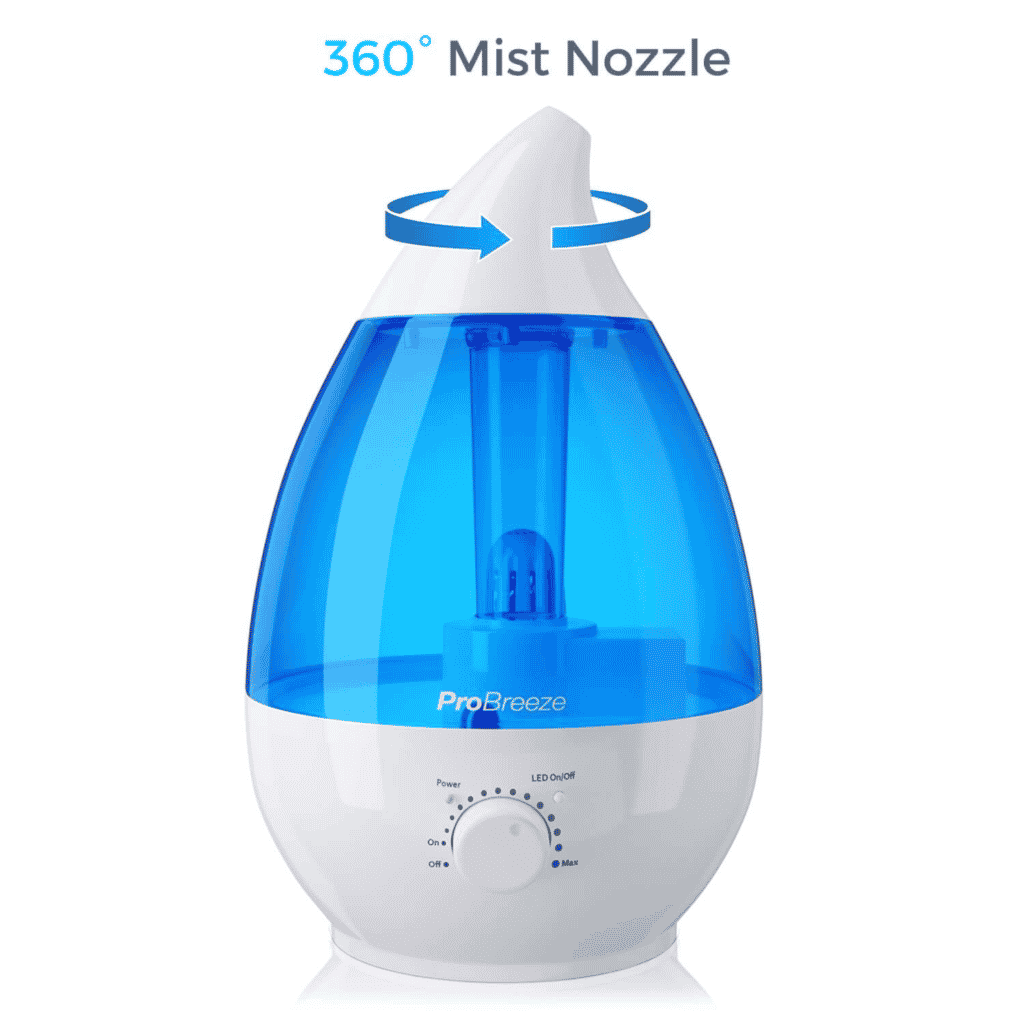
Image Source: Pro Breeze
Ultrasonic humidifiers are generally built with ceramic or metal material, and they come with the option of both warm mist and cool mist humidity machine. They create vibrations that further make droplets expel humidity within the environment.
Along with being reticent, this device also consumes less energy to operate. This makes them a perfect fit for kids and areas like bedrooms to avoid hearing loud operating noises.
How does a humidifier work?
Even though the anatomy of a humidifier dramatically varies according to the type you’re using, they generally work by maintaining relative humidity levels in the area. The air’s temperature affects the humidity range at a more excellent place.
The air during winter is dry and cold, holding much less water than the warmer air. It’s the underlying reason that humidifiers are more prevalent in cold weather.
Let’s first briefly understand the concept of relative humidity before anything else!
The concept of humidity is related to the presence of moisture in the air; the warmer the air, the more moisture it can hold, and vice-versa. For instance, you will experience high humidity in heavy rains and low humidity in areas such as deserts.
There is a certain amount of water vapor present in the air. The temperature of the air will decide the amount of water vapor a mass of air can contain. Thus, the warmer air holds more water. The air will get dry and hold much less moisture at the same temperature, especially when there is low relative humidity.
Thus, relative humidity plays an essential role in determining our comfort level. Let’s suppose the relative humidity is 100% In this case, the water will not evaporate!
Our bodies look for moisture evaporation from the skin to get a relaxed feeling. That’s because we feel calmer, especially since there is low relative humidity.
Thus, humidifiers work to maintain this relative humidity level in the range of 45% to 50% in a concerned area. It works by improving low-humid areas, which can affect us in the following ways:
- Our mucous membranes and skin completely dry out. The related symptoms can be seen in chapped lips, itchy skin, and sore throat.
- You will feel much colder than the actual environment or temperature. High humidity makes it warmer in the summer because sweat becomes difficult for sweat to evaporate from the body.
- It increases the static electricity waves for which you get the feeling of being sparkled every time you touch anything.
A humidifier can save you lots of bucks since it doesn’t cost more to humidify the air than heat it. Since a this generates humidity in the air, it produces heat or dispenses water from the wick filter.
Wicking filters are present in evaporative humidifiers. These kinds of filters absorb the moisture from the basin. A fan then spreads air through the moistened filter to create humidity.
It will be hard for the these devices to evaporate the water if the relative humidity is also higher. This is why most humidity machine are self-regulating; thus, they adjust the humidity level automatically depending on the room temperature.
Then, vaporizers or steam work by boiling water and releasing warm steam into the air to create humidity. These are the least expensive and most effortless types to create humidity in the air.
A rotating disc works or operates as a comb-like diffuser in an impeller humidifier model. It further splits the water into tiny droplets that you will see floating into the air. Vapor can generally be seen as a cool mist exiting these devices.
How to clean a humidifier with vinegar?
You can’t just buy and keep the humidifier as it is! It also needs an effective regular cleaning schedule to ban the entry of microbes or bacteria into the air. Yes, a dirty humidifier can emit dirty droplets into the air making your environment more dangerous.
You must also note the manufacturer’s instructions for special care of a concerned device, as every device differs in build structure and features.
Here is your ultimate guide on cleaning a humidifier internally and externally. So, let’s begin without any further delay!
You will need the following things to clean a humidifier:
- Water
- White distilled vinegar
- Soft toothbrush
- Liquid chlorine bleach
Step 1: Disassemble the humidifier
In the beginning, move ahead by exiting each piece of your moisture device if it can be disassembled. Start by emptying the water tank and detaching the removable parts. Remove the filter as well and simply decide to replace it instead of cleaning a dusty or odor-rich filter. It won’t be of any use!
Step 2: Clean your humidifier parts with vinegar
Take white distilled white vinegar, dilute it warm to make it a less concentrated solution, and pour it into the humidifier’s water tank. For the removable parts, you can soak them in this cleaning solution.
Now, fill everything out from the air moisturizer and scrub the inners with a soft-bristled brush to remove residues. Preferably, you need to use a soft brush with a flexible head.
Step 3: Disinfect your humidifier
After cleaning your humidifier with vinegar, take chlorine bleach to remove any residual bacteria from the tank. Take one teaspoon of chlorine bleach liquid and mix it with 1 gallon of cold water. Pour this solution up to half within the humidifier tank. Let the solution swish inside for a while and sit there for around 20 minutes.
Step 4: Let it dry!
Put each removed part of the humidifier under running water and rinse it several times until the bleach fumes are gone. Before you reassemble all its parts, make sure it gets dry ultimately. Repeat this cleaning process at least once a week and also before when you store it at the end of the dry season.
And, if you want to know how to clean a humidifier with hydrogen peroxide, follow the similar steps given above, except disinfecting. It’s because you can disinfect the humidifier with hydrogen peroxide as well!
How to clean a humidifier with hydrogen peroxide?
Note: Remember not to combine hydrogen peroxide and vinegar in the same container, as that produces an unwanted chemical reaction.
- Mix hydrogen peroxide and water in a ratio of 1:4, respectively.
- Fill the humidifier with the above solution and let it sit for at least 30 minutes.
- Take out the solution and rinse the tank thoroughly with clean water.
- Let it dry before you reassemble all the parts.
Final Words
So, how to clean a humidifier from disassembling it to reassembling all its parts. We’ve looked at every aspect of it from its basics, types, working mechanisms and different ways to disinfect your air moisturizer to remove bacteria. Always consider purchasing this device as per your needs keeping in mind the characteristics, differences etc. of the children.
FAQs
Q. Is it safe to use vinegar to run through the humidifier?
Ans: The simple answer is ‘No.’ Vinegar is only meant to clean a moisture device and not to run through it. It’s best not to. It can irritate your nose, lungs, throat, and eyes.
Q. Can a dirty humidifier lead to health issues?
Ans: Yes, dirty or unclean air moisturizers are home to various diseases such as asthma or allergies. It can cause lung infections or trigger flu-like symptoms even in fit people.
Q. Are the boiled water and distilled water the same?
Ans: There’s a difference in temperature between boiled and distilled water. Boiled water is water that has increased temperature, whereas distilled water can be at average room temperature. Boiled water can also kill dangerous bacteria. All the impurities, such as microorganisms or minerals, are removed in distilled water.
Q. When should I use a humidifier?
Ans: You should use this especially in the dry winter season, or if you suffer from hay fever symptoms, chronic runny nose, dry throat, asthma, nose bleeds, and sinus congestion.
Q. Is it reasonable to sleep with a humidifier?
Ans: Yes, it’s best to sleep with a this humidity machine at night in summer, it will help give you relief from the symptoms of seasonal allergies or dry air.
Q. Is a humidifier good for the lungs?
Ans: Increased humidity may ease breathing in adults or children with asthma or allergies, especially during a respiratory infection such as a cold.
Q. Does the humidifier increase oxygen?
Ans: The amount of oxygen present in the room is automatically increased with the presence of humidifiers. It can further alleviate symptoms of fatigue and headaches and make you more energetic.
Q. Does a humidifier help with allergies?
Ans: Yes, a this can help relieve the symptoms of allergies while offering relief from thin mucus and flushing all allergens.

